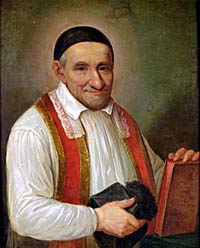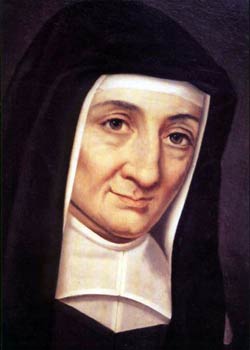Readings:
Micah 3:1-12
Psalm 37:1-17
Philippians 2:12-15
Matthew 18:18-20Preface of Baptism
[Common of a Prophetic Witness]
[Common of a Pastor]
[For Social Service]
[For Prophetic Witness in Society]
PRAYER (traditional language)
Most Gracious God, who hast bidden us to act justly, love mercy, and walk humbly before thee; Teach us, like thy servants Vincent de Paul and Louise de Marillac, to see and to serve Christ by feeding the hungry, welcoming the stranger, clothing the naked, and caring for the sick; that we may know him to be the giver of all good things, through the same, Jesus Christ our Lord. Amen.
PRAYER (contemporary language)
Most Gracious God, who has bidden us to act justly, love mercy, and walk humbly before you; Teach us, like your servants Vincent de Paul and Louise de Marillac, to see and to serve Christ by feeding the hungry, welcoming the stranger, clothing the naked, and caring for the sick; that we may know him to be the giver of all good things, through the same Jesus Christ our Lord. Amen.
Lessons revised at General Convention 2024.
Return to Lectionary Home Page
Webmaster: Charles Wohlers
Last updated: 11 Jan. 2025
VINCENT DE PAUL
HELPER OF THE
POOR, 27 Sept. 1660
 Vincent
de Paul was born in Gascony in about 1580, of peasant stock. He was an
intelligent lad, and his father sent him off to be educated. He was ordained
at twenty, and at first was interested chiefly in a successful career.
But when he was thirty, he accepted a post as chaplain and tutor in the
household of Philip de Gondi, Count of Joigny. This brought him into contact
with the peasants on the Gondi estate, and he became concerned for their
needs, physical and spiritual. A peasant who believed himself to be dying
confessed to him that his previous confessions for many years had been
dishonest. Vincent began to preach in the local church on confession,
repentance, forgiveness, and the love of God. His sermons drew such crowds
of penitents that he had to call in a group of other priests to assist
him. He took on the pastorship of a neighboring church attended by a more
fashionable and aristocratic crowd, and there he likewise drew many of
his listeners to repentance and amendment of life. Returning to Paris,
he worked among the prisoners destined for the galleys who were being
held at the Conciergerie.
Vincent
de Paul was born in Gascony in about 1580, of peasant stock. He was an
intelligent lad, and his father sent him off to be educated. He was ordained
at twenty, and at first was interested chiefly in a successful career.
But when he was thirty, he accepted a post as chaplain and tutor in the
household of Philip de Gondi, Count of Joigny. This brought him into contact
with the peasants on the Gondi estate, and he became concerned for their
needs, physical and spiritual. A peasant who believed himself to be dying
confessed to him that his previous confessions for many years had been
dishonest. Vincent began to preach in the local church on confession,
repentance, forgiveness, and the love of God. His sermons drew such crowds
of penitents that he had to call in a group of other priests to assist
him. He took on the pastorship of a neighboring church attended by a more
fashionable and aristocratic crowd, and there he likewise drew many of
his listeners to repentance and amendment of life. Returning to Paris,
he worked among the prisoners destined for the galleys who were being
held at the Conciergerie.
(A reader asked whether "galleys" was a misprint for "gallows". No, until fairly recently (certainly into the 1820's) French convicts were often sentenced to pull the oars on ships. There is a an essay on the subject by the historian W H (Warren) Lewis (brother of C.S. Lewis) in the book Essays Presented To Charles Williams, Oxford U Press, about 1945. The best known account is in the novel Les Miserables, by Victor Hugo, which contains several long essays on the galley system. Hugo's novels often have long sections where the action stops completely, while the author explains to the reader some aspect of French culture or history. The novelist Ayn Rand, who considers Hugo the world's greatest novelist, complains that these sections affect her like commercials interrupting a television drama. It seems an odd complaint from the author of Atlas Shrugged, but I digress.)
In 1625 he established the Congregation of the Mission (now known as the Vincentians, or the Lazarists), a community of priests who undertook to renounce all ecclesiastical advancement and devote themselves to work in the small towns and villages of France. In an age not noted for "interdenominational courtesy," he instructed his missioners that Protestants were to be treated as brothers, with respect and love, without patronage or condescension or contentiousness. Wealthy men and women came to him, expressing a wish to amend their lives, and he organized them into a Confraternity of Charity, and set them to work caring for the poor and sick in hospitals and in home visits. In 1633 the Archbishop or Paris gave him the Priory of St Lazare as a headquarters. There he offered retreats six times a year for those who were preparing for the ministry. These lasted two weeks each, and each involved about eighty students. He then began to offer similar retreats for laypersons of all classes and widely varying backgrounds. He said (identifying Lazarus of the Parable with Lazarus of Bethany):
This house was formerly used as a retreat for lepers, and not one of them was cured. Now it is used to receive sinners, who are sick men covered with spiritual leprosy, but are cured by the grace of God. Nay, rather, they are dead men brought back to life. What a joy it is to think that the house of St Lazare is a house of resurrection! Lazarus, after he had been four days in the tomb, came out alive, and our Lord who raised him up still gives the same grace to many who, after staying here some days as in the grave of Lazarus, come out with a new life.
Out of his Confraternity of Charity there arose an order of nuns called the Daughters (or Sisters) of Charity, devoted to nursing those who were sick and poor. He said of them, "Their convent is the sick-room, their chapel the parish church, their cloister the streets of the city." Many babies were abandoned in Paris every year, and when Vincent saw some of them, he established an orphanage for them, and thereafter often wandered through the slums, looking in corners for abandoned babies, which he carried back to the orphanage.
He complained to the King that ecclesiastical posts were distributed simply as political favors, and that the spiritual qualifications of the appointees were simply ignored. The King responded by creating a Council of Conscience to remedy the matter, with Vincent at the head. On one occasion, a noblewoman of the court, furious with Vincent because he refused to nominate her son for a position as bishop, threw a stool at him. He left the room with a stream of blood pouring from his forehead, and said to a companion who was waiting for him, "Is it not wonderful how strong a mother's love for her son can be?" He died 27 September 1660.
by James Kiefer
LOUISE DE MARILLAC
MONASTIC, WORKER OF CHARITY, 1660
 Louise de Marillac DC, (August 12, 1591 – March 15, 1660) was the co-founder, with Vincent de Paul, of the Daughters of Charity. She was born out of wedlock near Le Meux, in Picardy. She never knew her mother, but Louis de Marillac, Lord of Ferrires (1556-1604), claimed her as his natural daughter yet not his legal heir.
Louise de Marillac DC, (August 12, 1591 – March 15, 1660) was the co-founder, with Vincent de Paul, of the Daughters of Charity. She was born out of wedlock near Le Meux, in Picardy. She never knew her mother, but Louis de Marillac, Lord of Ferrires (1556-1604), claimed her as his natural daughter yet not his legal heir.
When she was 22, her uncle arranged for her to marry Antoine Le Gras, secretary to Queen Marie. Antoine was an ambitious young man who seemed destined for great accomplishments. Louise and Antoine were wed in the fashionable Church of St. Gervaise on February 5, 1613. In October, the couple had their only child, Michel. Louise grew to love Antoine and was an attentive mother to their son. Along with being devoted to her family, Louise was also active in ministry in her parish. She had a leading role in the Ladies of Charity, an organization of wealthy women dedicated to assisting those suffering from poverty and disease.
Antoine contracted a chronic illness and eventually became bedridden. Louise vowed not to remarry if her husband died before her. She also believed that she had received the insight that she would be guided to a new spiritual director whose face she was shown. When she happened to meet Vincent de Paul, she recognized him as the priest from her vision.
In 1625, Antoine died. Widowed and lacking financial means, she had to move. Vincent lived near her new dwelling. His work needed many more helpers, especially ones who were peasants themselves and so would be closer to the poor. He also needed someone who could teach and organize them. In 1629, Vincent invited Louise to become involved in his work with the Confraternities of Charity. She found great success in these endeavors. In 1632, she became convinced that it was time to intensify her ministry with poor and needy persons.
Louise found the help she needed in young, humble country women, who had the energy and the proper attitude to deal with people weighed down by destitution and suffering. She began working with a group of them and saw a need for common life and formation. Consequently, she invited four country girls to live in her home in the Rue des Fosses‐Saint‐Victor and began training them to care for those in need.
Mobility was a major innovation. The Daughters of Charity were unlike other established religious communities, whose religious women were behind cloister walls in a monastery and performed a ministry of contemplative prayer. "Love the poor and honor them as you would honor Christ Himself," Louise explained. That was the foundation of the Company of the Daughters of Charity, which received official approbation in 1655.
Louise led the Company of Daughters until her death. After increasingly ill health, she died six months before the death of her dear friend and mentor, Vincent de Paul. She was 68, and the Daughters of Charity had more than 40 houses in France. The nuns have always been held in high repute and have a presence in all parts of the world.
more at Wikipedia